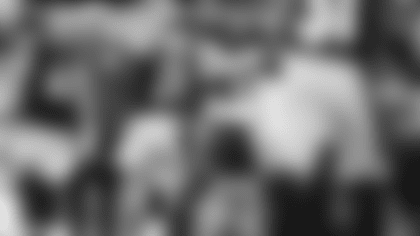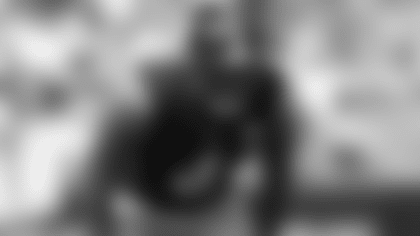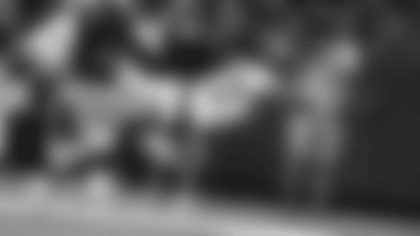Q. What were some of the factors you considered in making the decision about how much the regulars would or would not play in today's preseason finale against the Lions?
A. If you're going to box you need to spar, that's the reality of it all, and on Sept. 11, we have a boxing match. And so today is our last opportunity to spar. We're going to get some rounds in if you will, to make sure that we're fight ready. I'm just a firm believer in that. Not only in words but in action. That's why we probably practice a little bit differently than some others during the team development process. Every day that we have our pads on, there is some form of tackling, for instance. Because how are you going to ask guys to break tackles or to make tackles if you don't tackle? It's just that certain components of the game are tough to replicate unless you're playing the game. And so we're gonna allow those guys to work. We want to see their ability to execute great detail from an assignment standpoint, to execute some game-planning, to be able to do some of those things that are going to be a major component of Sept. 11 football.
Q. How many roster spots are at stake based on what happens in today's game?
A. Whenever you're going into this game, you always have probably 60 or so varsity-like candidates. And I always try to have an inclusive mentality as opposed to excluding people. Leaning in on this game, there are probably 60 or so guys who are showing varsity like traits, and they get an opportunity to put an exclamation point on their work today.
Q. Final cuts to get the roster down to 53 are due by 4 p.m. on Tuesday. With respect to those decisions, how is the time spent between the end of today's game and that deadline?
A. Some decisions you know instantly, the moment you walk off the field, even moments in-game. I think about Stefan Logan years ago runs that punt back 80 yards in Carolina, and by the time he got to the end zone he was on our roster, as one example. Those are the type of things that happen in the 11th hour when you get an opportunity to really put an exclamation point on your case for inclusion, and so it's ongoing. There's a lot of information to gather, and that starts, you know, yesterday. It's an ongoing process.
Q. In this job with the Steelers, you've never had to pick a starting quarterback coming out of the preseason for any reason other than a short-term absence of Ben Roethlisberger. This year it's a bit different because it's a longer-term situation. What will go into that decision?
A. Performance. The ability to lead. The ability to do the things, the unwritten things, or the informal things that the job prescribes for them to do. To assist in the growth and development of young, offensive eligibles and things of that nature. But ultimately, it's production, and the things that are critical at that position are the ability to anticipate with pinpoint NFL-like accuracy, what you do as plays break down or as you extend plays. Are you able to minimize negativity while also having the potential for splash? Those are the variables. All the guys have represented themselves very well. I've been pleased with the playmaking, but it kind of comes to a close as we walk out of the stadium today, and it's time to make some hardcore decisions and move forward. But I'll say this, it's not necessarily decision-making, it's just really calling what you see. And the guys hold the power, the quality or play is a determining factor, and so I'm excited for him.
Q. Are you truly still undecided on an opening day starter at quarterback, or is it a case where you want the candidates to sprint to the finish line of the competition?
A. It's a little bit of both. I certainly have some hardcore feelings about the direction we're headed, while at the same time I'm light on my feet because in-stadium performance is weighted differently, as it should be, because that's where the game is played. Practice is football-like; preseason games are football. We'll get an opportunity to see the Detroit Lions regulars for an extended period of time tonight. There will be some varsity ball out on this field, and so it's gonna be a big (final) week.
Q. Following today's game, there is nearly a two-week break before the start of the regular season. Do you handle that similar to an in-season bye, or is it something of a return to training camp?
A. It's an in-season by with higher intensity work. What I mean is the first week we're focused on us, Steelers vs. Steelers, and in the second week, obviously, we're leaning in on the opener. And that's also the general approach you take with a bye. A bye provides everyone with what it is they need. Some guys need rest. Some guys need rehabilitation. Some guys need work. At this stage of the journey, almost all of them need work. And so it's like a bye with a higher level of intensity and workload on the front end of it.
Q. This amount of time between games in early September is a relatively new part of the NFL calendar. Do you think this timeframe makes it more conducive for teams to add new players and then still be able to get them ready for the regular season opener?
A. I think time will tell that component of it. But also I don't think life is going to change that much for organizations, in terms of how they conduct business. It's just whether or not you're playing Carolina (in a fourth preseason game) at the end of next week. We're not (this year) but in the old system we did. Under the old system, you were multitasking. You had certain veteran players leaning down on the opener, some veteran players you were preserving. It's really not a lot of difference between the two schedules other than the fact of whether or not you're stepping into a stadium to play an opponent or not.
Q. When making a decision on whether to cut a particular player, is it ever a consideration that "he's the best we have" at a particular position so he's kept around, or is there a Mendoza line where if he's not above that bare minimum then a change just has to be made?
A. That's always an ongoing discussion, and that's why I use terms like varsity and JV. You have an idea of positional numbers you want to keep at certain positions, but only provided all of those guys are varsity. You don't want to be fixed at a position and keep somebody who's JV when you've got the global field out there. And that's why playing well is so important for all of these guys today. Forget how they stack up within the rooms or within the environment they're currently in. There's a global component to this thing, and if you're varsity and your play is varsity, you might not do enough to be employed in this environment, but you might be employable in another environment. So it behooves all the guys to put your best foot forward and play well and to be varsity. That's what I was talking about when I was talking about going into the last game and having an inclusive mentality about who potentially makes our roster. It could be potentially six guys who have shown a certain level of consistent varsity traits, and you just have got to be open to guys surprising you. You can't care by what means guys got here. You've got to give a guy an opportunity to show that he belongs. And they have to believe that, and in turn they make it reality.
Q. I cannot imagine it's easy for a player added to a team once the training camp train has left the station, but one guy who fits into that category is backup outside linebacker Hamilcar Rashed, who was added to your roster on Aug. 11. What made him an attractive prospect, and what have you seen from him since he got here?
A. I think NFL experience is a major component of getting on the moving train that you describe. He's not a rookie. He has played NFL football. He has been in NFL circumstances. And that's the component that gives them realistic opportunities. Undrafted college guys who get on that moving train are going to get consumed by it all. Rashed is new to us, but he's not new to the professional game. He's been in the last preseason game before and had to state his case for himself in an effort to make a ballclub and stuff like that. He has been exposed to some schematics, and often he's just learning what we call something as opposed to learning something from scratch. So those are the things that really give guys like him an opportunity to make it and state a case for themselves, and why it's so difficult for people who don't have NFL experience to make a legitimate push under those circumstances.
Q. Rashed entered the league as an undrafted rookie from Oregon State in 2021, so he undoubtedly was part of your pre-draft preparation that spring. What do you remember about that?
A. He had 14 sacks as a junior (in 2019), and he came back for a senior year and had zero on a COVID-shortened year (in 2020). He had some schematic changes defensively that probably played a role in that, and maybe he even had a coordinator change or philosophical change. So there were some things that made him somewhat attractive, that could have made him a valuable guy where he was slotted in the draft. That got our attention. He also has prototypical outside linebacker measurables, and that gets our attention. Some of those guys are college defensive ends, and there's a transitional component to you maybe being attracted to those guys. We're attracted to guys who play on two feet, who have the prototypical measurables. He had some production in his junior year that captured our attention. There were some tangible reasons why he lacked the production in his senior year, and so it merited investigation. And all of that has brought us to this point. That's just an example of how we pour into guys in draft preparation and how we stay connected to him, and in many instances maintain the interest even after they come into the league. When the Dolphins were deciding to move Minkah, it wasn't a long discussion about whether or not we were interested in Minkah. We had done that work 12 months prior when he came out in the draft, as an example.
Q. In a situation like the one in the game in Jacksonville when it comes to the offensive line, how do you tell whether it's simply a case of a bad performance vs. whether the players are below the line and changes have to be made there?
A. The component of what transpired in Jacksonville that I didn't talk a whole lot about because really it's irrelevant in this setting, is the lack of game planning, the preseason component of play. It was highly probable that they were going to get after us because they were playing their third preseason game with more game planning and more detail regarding schematics and matchup-related things, and we were playing our second preseason game that was in their environment. I'm not seeking comfort there. I'm not providing an out. But that's just the reality. And so if you bring an old conversation up, I'll give you that truth. But this week, game planning and us being personnel matchup conscious, there's a reasonable expectation that we don't see the things that we saw last week in that stadium. But failure and misery are good for growth and development, and that's why I didn't mind what transpired a week ago.
Q. On cut-down day and during the 24 hours immediately after, in your experience what position players are most in demand by teams looking to upgrade?
A. Big bodies. There's a big man scarcity on the planet, and big bodies always attract a certain amount of attention. An old basketball guy once told me 1-of-4 seven-footers, at some point in time, plays in the NBA over the course of his life. If he's an American male and is 7-feet tall, 1-of-4 at some point in his life is going to spend at least one game on an NBA bench. That just kind of highlights the scarcity of big men on the planet, and it's the same if you equate it to football bodies. There's a scarcity of 6-6, 325 pound men on the planet. And that attracts a certain amount of attention.














